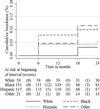Incidence of HIV Infection and Sexually Transmitted Infections and Related Risk Factors Among Very Young Men Who Have Sex With Men
- PMID: 26745827
- PMCID: PMC4837074
- DOI: 10.1097/QAI.0000000000000933
Incidence of HIV Infection and Sexually Transmitted Infections and Related Risk Factors Among Very Young Men Who Have Sex With Men
Abstract
Introduction: The HIV epidemic continues to disproportionately affect men who have sex with men (MSM) in the United States, with over a third of new infections in MSM occurring in younger men. Very few studies have reported on HIV and sexually transmitted infection (STI) incidence and related risks among younger MSM, particularly among minors under 18 years of age.
Methods: Data analyzed herein are from a longitudinal study of HIV risk among 450 very young MSM in Chicago aged 16 to 20, recruited via respondent-driven sampling and followed-up for 2 years, with annual HIV and STI testing. We report estimated cumulative HIV and STI incidence over the 24-month follow-up using Kaplan-Meier methods and evaluated associations with incident infections using Cox proportional hazards regression.
Results: The final analytic sample was primarily non-white (83%); median age was 19; 25% of the sample was under age 18. Twenty-six new HIV infections were detected over 632 person-years of follow-up. HIV incidence was 4.11/100 person-years [95% confidence interval (CI): 2.80 to 6.04] and STI incidence was 6.22/100 person-years (95% CI: 4.54 to 8.51). Cumulative HIV incidence over 24 months of follow-up was 7.32% (95% CI: 5.05 to 10.57), with higher incidence among racial/ethnic minorities. In multivariate analyses, non-white race and recent sexual partner concurrency were associated with both HIV and STI infection; HIV testing history and sex with an HIV-positive partner were associated with increased risk of HIV infection.
Discussion: High rates of incident HIV infection and STIs among very young MSM and the relationship between incidence and race/ethnicity, concurrency and partner characteristics indicate potential focal points of future intervention and the need for continued vigilance.
References
-
- Centers for Disease Control and Prevention. HIV Surveillance Report, 2013. Atlanta, GA: Centers for Disease Control and Prevention; 2015.
-
- Centers for Disease Control and Prevention. Estimated HIV incidence among adults and adolescents in the United States, 2007–2010. Atlanta, GA: Centers for Disease Control and Prevention; 2012.
-
- Centers for Disease Control and Prevention. The young men who have sex with men (YMSM) project: Reducing the risk of HIV/STD infection. [Accessed March 3, 2014];2013 http://www.cdc.gov/healthyyouth/disparities/ymsm/index.htm.
Publication types
MeSH terms
Grants and funding
LinkOut - more resources
Full Text Sources
Other Literature Sources
Medical


